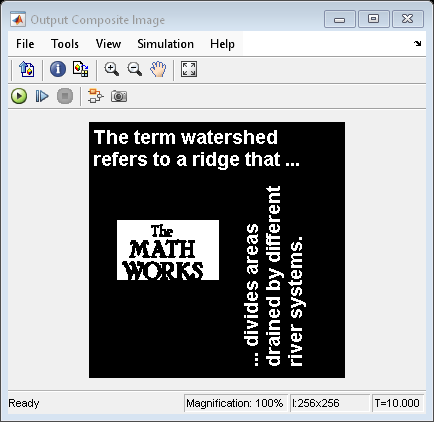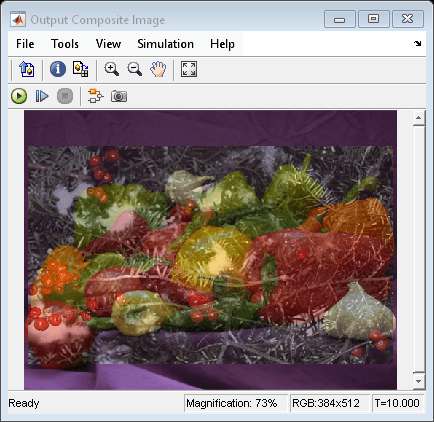Compositing
Combine two images or apply mask to image
Libraries:
Computer Vision Toolbox /
Text & Graphics
Description
The Compositing block combines two images, overlays one image over another, or highlights selected pixels in an image. When combining two images, the block uses this equation, in which the output image O is a linear combination of the two images and :
The opacity factor X scales each pixel before combining the images, where .
When overlaying one image over another image, or highlighting selected pixels in an input image, the block uses a binary mask to specify which pixels to overwrite or highlight.
Note
This block supports binary, intensity, and color images.
Examples
Ports
Input
Input image one, specified as an M-by-N matrix or M-by-N-by-P array. If the input is a M-by-N-by-P array, P is the number of color channels in the image.
Data Types: single | double | int8 | int16 | int32 | uint8 | uint16 | uint32 | Boolean | fixed point
Input image two, specified as an M-by-N matrix or M-by-N-by-P array. If the input is a M-by-N-by-P array, P is the number of color channels in the image.
Dependencies
To enable this port, set the Operation parameter to
Blend or Binary mask.
Data Types: single | double | int8 | int16 | int32 | uint8 | uint16 | uint32 | Boolean | fixed point
Binary mask, specified as a scalar or matrix. This mask determines which pixels of Image1 the block overwrites with the pixel values of Image2 or highlights, depending on the value of the Operation parameter.
Binary mask— The block overwrites the pixel values of Image1, indicated by the mask, with the corresponding pixel values of Image2. You can specify Mask as a scalar0or1, which the block uses for all pixels of Image2, or as binary matrix of same size as Image2.Highlight selected pixels— The block highlights the pixels of Image1 indicated by the mask.
Dependencies
To enable this port:
If overwriting pixel values in one image with pixel values in another image, set the Operation parameter to
Binary maskand the Mask source parameter toInput port.If highlighting selected pixels in an image, set the Operation parameter to
Highlight selected pixels.
Data Types: single | double | Boolean
Opacity factor, specified as a scalar or matrix. If specified as a scalar, the value is the scale of combination for each pixel of Image2 with each corresponding pixel of Image1. If specified as a matrix, its dimensions must match the dimensions of Image2. Each opacity factor must be in the range [0, 1].
Dependencies
To enable this port, set the Operation parameter to
Blend and the Opacity factor(s)
source parameter to Input port.
Data Types: single | double
Location index, specified as a two-element vector. The first element represents the row and the second represents the column position of the upper-left corner of Image2, relative to the upper-left corner of Image1. If the location of the upper-left corner of Image2 is such that any of its pixels would render outside the bounds of Image1, the block clips Image2 at the final row or column or Image1, instead.
Note
When the Image1 input has a fixed-point or boolean data type, the Location input must have a built-in integer data type.
Dependencies
To enable this port, set the Location source parameter to
Input port.
Data Types: single | double | int8 | int16 | int32 | uint8 | uint16 | uint32
Output
Output image, returned as an M-by-N matrix or M-by-N-by-P array. If the output is an M-by-N-by-P array, P is the number of color channels in the image.
Data Types: single | double | int8 | int16 | int32 | uint8 | uint16 | uint32 | Boolean
Parameters
Main
Select the image operation for the block to perform.
Blend— Linearly combines the pixel values of Image1 with the pixel values of Image2, with the specified opacity factor.Binary mask— Overwrites the pixel values of Image1 with the values of Image2 specified by the binary mask.Highlight selected pixels— Highlights the pixels of Image1 indicated by the binary mask. The highlight operation assign the highest intensity or color values to the pixels of Image1 corresponding to the pixels with logic 1 of the binary mask.
Specify the source of the opacity factor. If you set this parameter to
Input port, it enables the Factor
input port.
Dependencies
To enable this parameter, set the Operation parameter to
Blend.
Defines the scale of combination for each pixel of Image2 with each corresponding pixel of Image1. When you specify the opacity factor as matrix, its dimensions must match the dimensions of Image2. If you specify it as a scalar, the block uses that value as the opacity factor for all pixels of Image2. The opacity factor must be in the range [0, 1].
Dependencies
To enable this parameter, set the Operation parameter to
Blend and the Opacity factor(s)
source parameter to Specify via
dialog.
Select the source of the overlay location. If you set this parameter to
Input port, it enables the Location
input port.
Specify the row and column position of the upper-left corner of Image2, relative to the upper-left corner of Image1, as a two-element vector. If the location of the upper-left corner of Image2 is such that any of its pixels would render outside the bounds of Image1, the block clips Image2 at the final row or column or Image1, instead.
Dependencies
To enable this parameter, set the Location source parameter
to Specify via dialog.
Select the source of the binary mask. If you set this parameter to
Input port, it enables the Mask
input port.
Dependencies
To enable this parameter, set the Operation parameter to
Binary mask.
Binary mask, specified as a scalar or matrix, defines which pixels of
Image1 the block overwrites with the corresponding pixel values
of Image2 or highlights. You specify 0 or
1, which the block uses for all pixels in
Image2, or a binary matrix of the same size of as
Image2.
Dependencies
To enable this parameter, set the Operation parameter to
Binary mask and the Mask source
parameter to Specify via dialog.
Data Types
For details on the fixed-point block parameters, see Specify Fixed-Point Attributes for Blocks (DSP System Toolbox).
Block Characteristics
Data Types |
|
Multidimensional Signals |
|
Variable-Size Signals |
|
Extended Capabilities
C/C++ Code Generation
Generate C and C++ code using Simulink® Coder™.
Version History
Introduced before R2006a
See Also
MATLAB Command
You clicked a link that corresponds to this MATLAB command:
Run the command by entering it in the MATLAB Command Window. Web browsers do not support MATLAB commands.
选择网站
选择网站以获取翻译的可用内容,以及查看当地活动和优惠。根据您的位置,我们建议您选择:。
您也可以从以下列表中选择网站:
如何获得最佳网站性能
选择中国网站(中文或英文)以获得最佳网站性能。其他 MathWorks 国家/地区网站并未针对您所在位置的访问进行优化。
美洲
- América Latina (Español)
- Canada (English)
- United States (English)
欧洲
- Belgium (English)
- Denmark (English)
- Deutschland (Deutsch)
- España (Español)
- Finland (English)
- France (Français)
- Ireland (English)
- Italia (Italiano)
- Luxembourg (English)
- Netherlands (English)
- Norway (English)
- Österreich (Deutsch)
- Portugal (English)
- Sweden (English)
- Switzerland
- United Kingdom (English)


